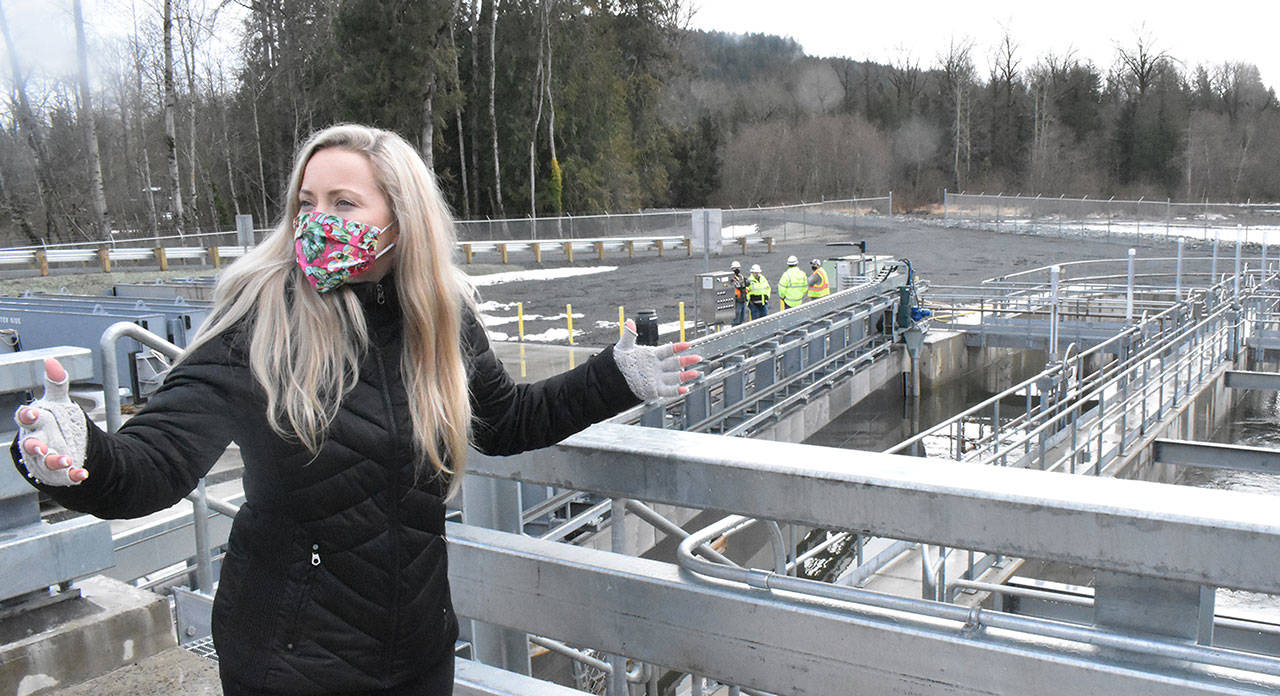A massive undertaking that spans the White River, a project that required more than $130 million in public money and aims to protect endangered salmon runs, is nearing completion.
Dubbed the Mud Mountain Dam Fish Passage facility, the construction site is headed toward full operational status this month. And few folks will see it, as it sits just upstream of the White River Bridge between Enumclaw and Buckley.
It’s not like the U.S. Army Corps of Engineers wants visitors, though. The site is home to a handful of employees and, really, it’s all about the fish.
The Corps has operated a trap-and-haul facility on the river for eight decades but – for environment and political reasons – the existing operation was no longer meeting demands. So, once the necessary Congressional funding was in place, plans for a new facility began to steamroll. The effort culminated the afternoon of Feb. 17 with a ribbon-cutting ceremony.
Here are a few interesting tidbits tied to the construction on the White River.
• The trap-and-haul operation that has served both people and fish since 1941 sat on the Pierce County side of the river and was accessed from Buckley. The new facility is based on the Enumclaw side.
• The change in location means something to those who travel state Route 410. Trucks hauling fish have always pulled onto the highway on the Buckley side of the White River Bridge; now, trucks will leave the facility and travel Mud Mountain Dam Road before joining 410 at Enumclaw’s eastern edge.
• The new facility, which was tested successfully during the winter, is the largest of its kind in the nation. Project Manager Leah Hauenstein said it might be the largest trap-and-haul operation in the world; efforts to find one that exceeds the scope of the White River facility, she said, have turned up nothing.
A BIT OF HISTORY
The White River was forever changed when the Corps built Mud Mountain Dam, which sits about six miles upstream from the trap-and-haul facility. It was constructed as a “risk management” tool, protecting people, homes and businesses that sit along the White and Puyallup river valleys. It’s an earthen, rock-filled structure that put an end to widespread flooding of the valley floor downstream from the Enumclaw Plateau. It was started prior to America’s entry into World War II, put on hold, then finished post-war.
Dams, of course, create a barrier and halt the natural flow of the river. Construction prohibits spawning salmon from reaching their instinct-driven destination.
So, to mitigate the calamity facing the fish population, the Corps had built a trap-and-haul facility in 1941. Since then, salmon have been captured, dumped into trucks and transported upstream past the dam where they’re returned to the river.
The facility is inadequate by today’s standards to move the Endangered Species Act-listed Puget Sound steelhead, Puget Sound Chinook, and bull trout. The current and new facilities must also move non-listed coho and pink salmon.
The 1941-built facility was designed to move 20,000 fish annually. During pink salmon migration, in odd years, it manages to move upwards of 20,000 fish per day. The new facility is designed to transport 60,000 fish a day, upwards of 1.2 million fish per year, during pink run years (like 2021).
ABOUT THOSE BELOVED ORCAS
A driving force behind any effort to save salmon is the need to protect the pods of Orca (aka killer whales) that call Puget Sound home. They feed on Chinook salmon and, when Chinook numbers drop, Orca numbers do the same.
According to information provided by the U.S. Army Corps of Engineers, the last three years have seen record Chinook salmon returns on the White River. The Corps attributes that to the collaborative work of multiple entities; chief among those are the National Oceanic and Atmospheric Administration, U.S. Fish and Wildlife, the Muckleshoot and Puyallup tribes, and the state’s departments of Ecology and Fish and Wildlife.
When it comes to White River Chinook, the 2017 count was 16,271, a 174 percent increase over 2016’s 9,347 total, which was the best seen in 71 years of return records. The Corps says Chinook saw historical lows about 20 years ago, when only a few dozen Chinook could be counted.
Corps and NOAA officials worked together, discussing details about dam operations before NOAA issued a formal recommendations for major improvements in the dam’s fish passage operations. Eventually, the Corps of Engineers’ regional design team included more than 150 employees from three Corps districts and two architecture and engineering firms. Several regional stakeholders also collaborated in the design, including the Muckleshoot Indian Tribe, Cascade Water Alliance and National Marine Fisheries Service.
The contract to build the trap-and-haul facility was awarded by Corps officials March 14, 2018. Kiewit Infrastructure West Company’s $112 million bid earned it the contract award.


